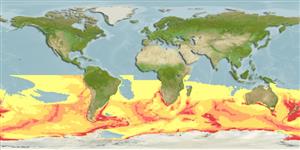Common names from other countries
Classification / Names / Names
Common names | Synonyms | Catalog of Fishes (gen., sp.) | ITIS | CoL | WoRMS
Environment: milieu / climate zone / depth range / distribution range
Ecology
Bathydemersal. Polar; 0°N - 90°S, 180°W - 180°E
Indo-Pacific, Atlantic Ocean, and the Antarctic.
Length at first maturity / Size / Weight / Age
Maturity: Lm ? range ? - ? cm Max length : 300 cm TL male/unsexed; (Ref. 1394); 360 cm TL (female); max. published weight: 450.0 kg (Ref. 1394); max. published weight: 450.0 kg
Found throughout the pack ice zone; haul out on ice and land, often preferring ice floes, when available. Feeds on krill, fish, squid, penguins, and young seals, and will occasionally scavenge from carcasses of whales (Ref. 1394).
Jefferson, T.A., S. Leatherwood and M.A. Webber. 1993. (Ref. 1394)
IUCN Red List Status (Ref. 130435: Version 2024-1)
CITES status (Ref. 108899)
Not Evaluated
Not Evaluated
Human uses
Fisheries: commercial
FAO - Fisheries: species profile | FishSource | Sea Around Us
Tools
Internet sources
Estimates based on models
Preferred temperature
(Ref.
115969): -1.9 - 1.4, mean -0.5 (based on 2109 cells).
Resilience
High, minimum population doubling time less than 15 months (K=0.36-0.47).
Vulnerability
High to very high vulnerability (68 of 100).
Price category
Unknown.
